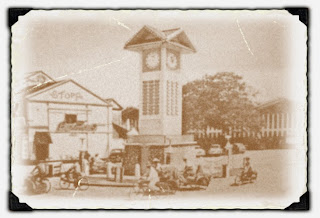A Long Way From the Shore
While walking in West London this morning something astonishing appeared in my footstep. I recognised it at once as the buöh gömök of Old Trengganu, as we used to collect from the shore of Ujong Tanjong among the debris brought down by the waters from upstream, and then washed ashore by the waves at the kuala.
I don't know how this buöh gömök came to West London, but looking at it closely I saw that an eyelet had been embedded into it to take a string or lanyard. In fact, if you look closely at the photo you'll see there a bit of string still, so I suspect that this seed has been swung around, served as a pendant, or has knocked many times against another in the manner of ye old British conkers. It may have been brought here by someone from the West Indies, or it could have dropped from the pocket of a passing East Coast Malaysian (Pak Zawi?), or someone who's been to a US department store.
The buöh gömök is what's called buöh beluru in Kelantan (as I was told by Pak Zawi), and in Trengganu I suspect that mighty gömök trees grew along the riverbanks, upstream in the ulu where nobody but woodcutters and the Sang Kelambai ventured to go. If you see woodcutters in the wild, do, by all means, say hello, but if an elderly woman crosses your path in the woods, never give her the time of day, as she may be the Sang Kelembai whose glare will petrify you. And there you shall be, under the gömök tree, immobilised and unrescued, for ever more.
This gömök seed is a native of the old world tropics that embrace parts of India, the Philippine islands and the Nusantara, as well as some parts of China. Botanically it is known as Entada phaseoloides, and it has cousins and brothers in Africa (where it is known as E. rheedei) and in the New World (E. gigas). The gigas variety is hard and shiny brown just like our gömök but is also intriguingly heart-shaped. The entada comes in seed pods, much like our petai (Parkia speciosa ), and the Entada gigas holds the record for having the world's longest pod, some stretching to six feet in length.
Entada seeds must be among the world's most resilient. The heart-shaped gigas, coming adrift from South America, are carried by the currents to shores as far away as Norway. The phaseoloides visited us in Tanjong after being knocked about in the spiralling waters in the monsoon months, and in the United States, phaseoloides and rheedi seeds are sold in department stores, for use as anchoring base for dry flower arrangements, and as playthings for young minds uncorrupted by computer games and the telly. In Trengganu we picked these seeds from the shore, we spat on them and polished them and filled them with lead, and we used them as our kör.
The kernel of the gömök is used for medicine in many cultures, and the African variety, the rheedei, is also known as the Dream Seed for the hallucinogenic inducing properties of its kernel. In Tanjong we used to bore a hole on the side of the E. phaseoloides with a gimlet (ggörèk) and we'd leave the seed out overnight for ants to feed on and probably get high to the eyeballs on the kernel. The empty shell is then filled with heavy metal, long before heavy metal became the anthem of the sozzled.
Kernel Note: Please don't try anything suggested in the last paragraph at home as the results may scare you more than the petrifying stare of Sang Kelembai.
Labels: buöh gömök, E. gigas, E. rheedei, Entada phaseoloides, Sang Kelembai, Ujong Tanjong




